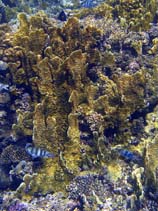Millepora platyphylla Hemprich & Ehrenberg, 1834
Wello fire coralWarning: DOMDocument::load(): SSL operation failed with code 1. OpenSSL Error messages: error:140770FC:SSL routines:SSL23_GET_SERVER_HELLO:unknown protocol in C:\Apache24\htdocs\includes\SpeciesSummary.lib.php on line 1236
Warning: DOMDocument::load(): Failed to enable crypto in C:\Apache24\htdocs\includes\SpeciesSummary.lib.php on line 1236
Warning: DOMDocument::load(https://sealifebase.nrm.se/webservice/AquaMaps/getAMap.php?genus=Millepora&species=platyphylla): failed to open stream: operation failed in C:\Apache24\htdocs\includes\SpeciesSummary.lib.php on line 1236
Warning: DOMDocument::load(): I/O warning : failed to load external entity "https://sealifebase.nrm.se/webservice/AquaMaps/getAMap.php?genus=Millepora&species=platyphylla" in C:\Apache24\htdocs\includes\SpeciesSummary.lib.php on line 1236
Classification / Names Common names | Synonyms | CoL | ITIS | WoRMS
| Anthoathecata | Milleporidae
Environment: milieu / climate zone / depth range / distribution range Ecologia
Associadas(os) a recifes; intervalo de profundidade 3 - 6 m (Ref. 8294). Tropical
Distribuição Países | Áreas FAO | Ecossistemas | Ocorrências | Introduções
Indo-Pacific: West to Red Sea; north to Japan; east to Marquesas; and south to Houtman Abrolhos Islands.
Length at first maturity / Tamanho / Peso / Idade
Maturity: Lm ? range ? - ? cm Max length : 300 cm WD macho/indeterminado; (Ref. 269); common length : 200 cm WD macho/indeterminado; (Ref. 269)
Descrição suscinta Morfologia
Forms large colonies, commonly 200 to 300 cm in diameter and composed of anastomosed vertical plates, which may reach 200 cm in height. In life, colonies have a characteristics light brown, color, with white growing edges. If touched, a sharp sting can be felt when coming into contact with soft skin (Ref. 269).
Forms large colonies, commonly 200 to 300 cm in diameter and composed of anastomosed vertical plates, which may reach 200 cm in height (Ref. 269). Depth based from occurrence (Ref. 8294); to be replaced with a better reference. Most common in shallow to intermediate depths (Ref. 269).
Life cycle and mating behavior Maturidade | Reprodução | Desova | Ovos | Fecundidade | Larvas
Members of the order Anthoathecata are mostly colonial A-form hydroids. Life cycle: The zygote develops into planula inside the gonophore and is later released as an actinula which metamorphoses into polyp stage.
Referência principal
Referências | Coordenador | Colaboradores
Ross, M.A. and G. Hodgson. 1981. (Ref. 8294)
Status na Lista Vermelha da IUCN (Ref. 130435)
Segura ou pouco preocupante (LC) ; Date assessed: 01 January 2008
Status no CITES (Ref. 108899)
Appendix II: International trade monitored
CMS (Ref. 116361)
Not Evaluated
Perigo para os humanos
Uso pelos humanos
| FishSource |
Ferramentas
Mais informação
Fontes da internet
BHL | BOLD Systems | CISTI | DiscoverLife | FAO(Publication : search) | Fishipedia | GenBank (genoma, nucleotídeo) | GloBI | Gomexsi | Google Books | Google Scholar | Google | PubMed | Árvore da vida | Wikipedia (Ir para, procura) | Registro zoológico
Estimates based on models
Preferred temperature
(Ref. 115969): 24.5 - 29.3, mean 28.4 (based on 3478 cells).
Categoria de preço
(Ref. 80766):
Unknown.



